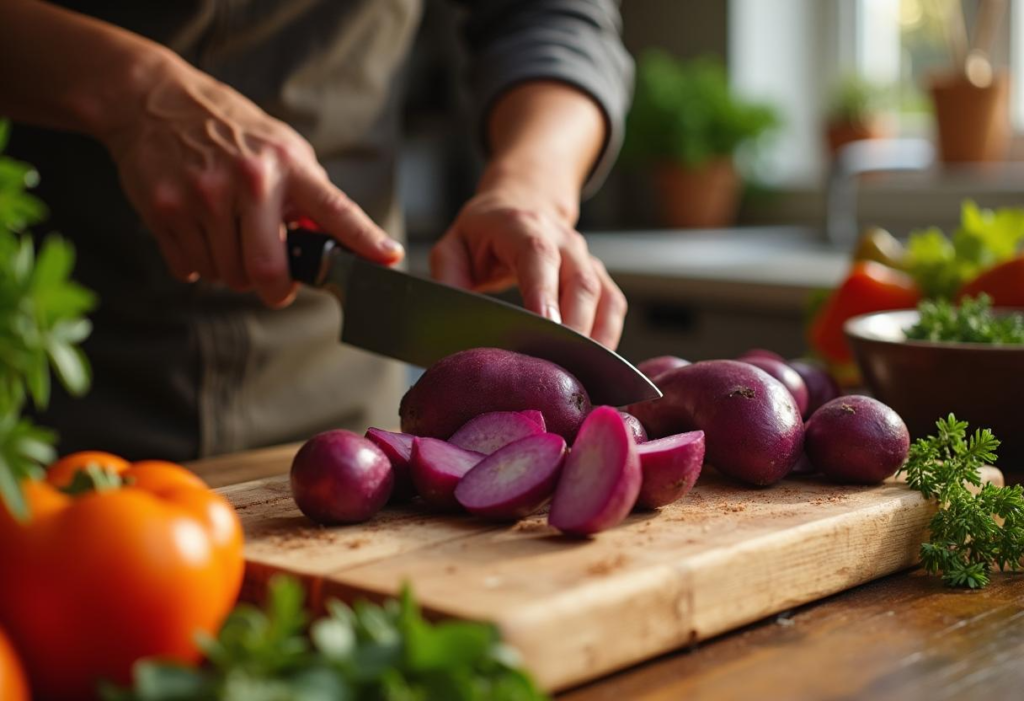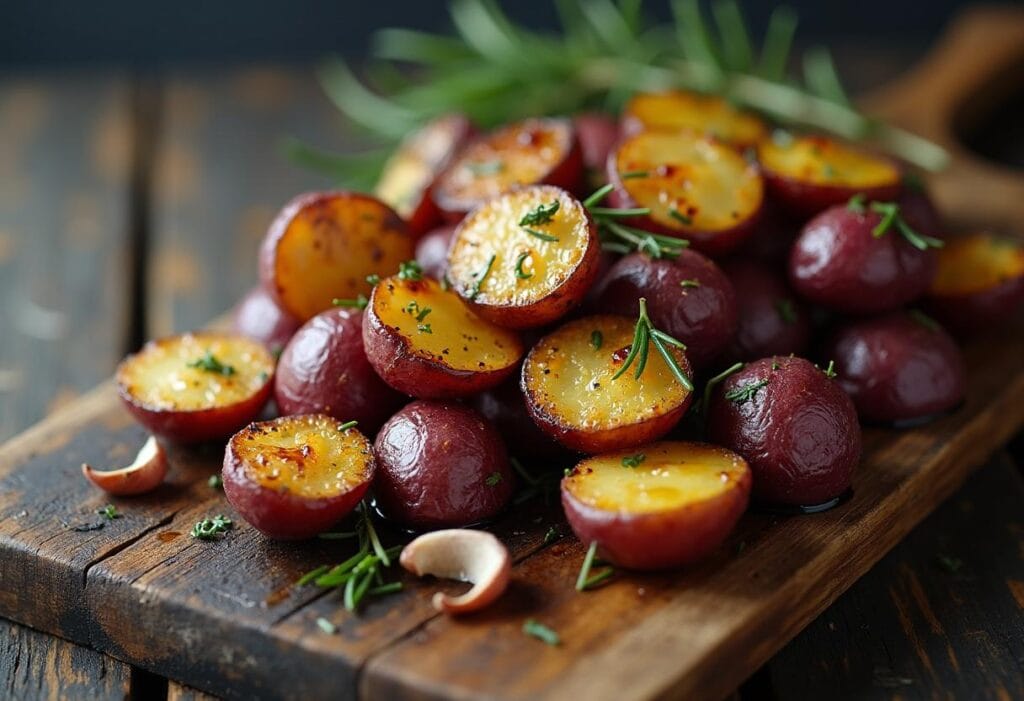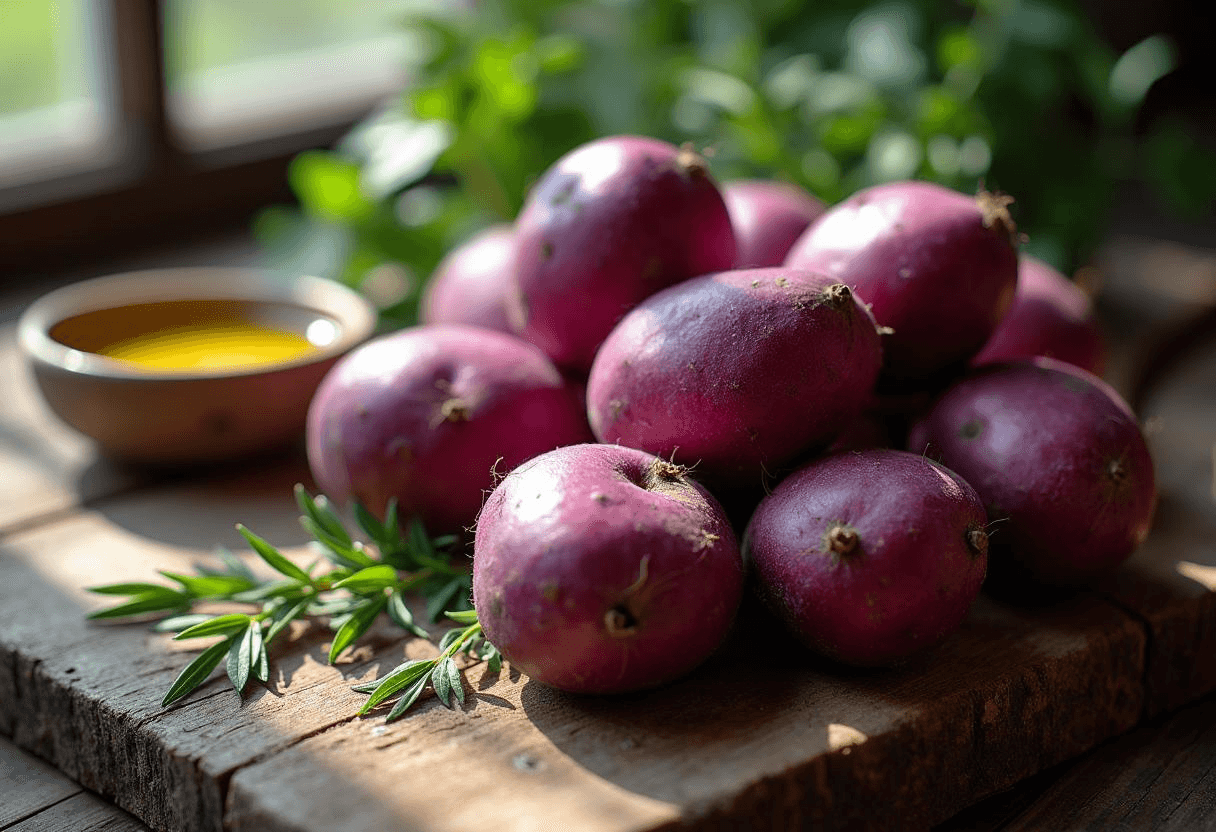Have you ever tried a vibrant purple potato and wondered how it compares to regular varieties? These colorful tubers have a unique flavor, texture, and nutritional profile that set them apart. But what exactly makes them special, and how can you best enjoy them in your meals?
But what makes them special? Is there any difference in taste, texture, or nutrition compared to regular potatoes? And most importantly—how can you use them in your kitchen to create delicious meals?
In this guide, we’ll break down everything you need to know about these vibrant tubers, from their nutritional value to the best ways to cook them. If you’re curious about how purple potatoes compare nutritionally, check out our detailed guide on Purple Potatoes vs. Regular Potatoes: Which One is Healthier?.
What Are Purple Potatoes?
The vibrant purple hue of these potatoes comes from anthocyanins, a type of antioxidant also found in blueberries. These compounds not only contribute to their color but also provide anti-inflammatory and heart-health benefits.
👉 Want to know how they compare to other potato types? Learn how purple potatoes stack up against red potatoes nutritionally.
Origin & History
Purple potatoes trace their roots back to Peru and Bolivia, where they’ve been cultivated for thousands of years. In the Andean region, these potatoes were prized not just for their taste, but also for their nutritional and medicinal benefits.
Over time, they spread to North America, Europe, and Asia, gaining popularity for their vibrant color and health perks.
Types
Not all these colorful spuds are the same! Here are some of the most common varieties:
- Purple Majesty – Deep purple inside and out, with a smooth, creamy texture.
- Purple Peruvian – A firmer variety, great for roasting or making chips.
- Vitelotte – A French heirloom variety with an intense nutty flavor.
- Adirondack Blue – Often mistaken for naturally purple potatoes, but actually more bluish in color.
Each type has a slightly different flavor and texture, making them versatile for various cooking methods. For a deeper dive into the different varieties, check out our guide on The Most Popular Types of Purple Potatoes & Their Best Uses

How Do Purple Potatoes Get Their Unique Color?
The deep purple hue comes from anthocyanins, a type of antioxidant that fights inflammation and promotes good health. Interestingly, these same compounds are responsible for the color of blueberries, blackberries, and grapes!
“Nature gave purple potatoes their color for a reason—because they’re packed with nutrients that help your body thrive!”
Nutritional Value of Purple Potatoes
Purple potatoes contain more antioxidants and fiber compared to regular potatoes, making them a nutrient-dense option. If you’re interested in learning more about how different potato types affect your health, check out our article on The Best Potatoes for a Healthy Diet: Red, Yellow, or Purple?
Nutrition Facts (Per 100g Cooked Purple Potato)
| Nutrient | Purple Potato | Regular Potato |
|---|---|---|
| Calories | 87 kcal | 77 kcal |
| Carbohydrates | 20g | 17g |
| Fiber | 3g | 2.2g |
| Protein | 2g | 2g |
| Vitamin C | 18mg (20% DV) | 14mg (15% DV) |
| Potassium | 350mg | 429mg |
| Antioxidants | High | Low |
Purple Potatoes vs. Regular Potatoes: What’s the Difference?
More antioxidants – Thanks to anthocyanins, nutrient-rich potatoes offer better protection against disease.
Higher fiber content – Aiding digestion and keeping you full longer.
Slightly lower glycemic index – Making them a better option for blood sugar control.
Health Benefits of nutrient-rich potatoes
If you’re looking for a nutrient-packed alternative to regular potatoes, vibrant tubers are a great choice. Here’s why:
1. Rich in Antioxidants for a Stronger Immune System
The anthocyanins in purple potatoes help boost immunity, reduce inflammation, and protect cells from damage. This means they may lower the risk of chronic diseases like heart disease and cancer.
“Eating colorful foods isn’t just fun—it’s a smart way to get powerful antioxidants into your diet!”
2. Improves Heart Health & Blood Circulation
nutrient-rich potatoes contain potassium, which helps:
Regulate blood pressure
Improve circulation
Reduce the risk of heart disease
Studies show that eating anthocyanin-rich foods can help lower cholesterol and improve blood vessel function.
3. Supports Digestive Health & Gut Function
Thanks to their high fiber content, these colorful spuds help:
Promote gut health by feeding good bacteria
Prevent constipation and improve digestion
Stabilize blood sugar levels
4. May Help Manage Blood Sugar Levels
Unlike regular potatoes, these colorful spuds have a lower glycemic index (GI), leading to a slower blood sugar increase. This makes them a healthier choice for diabetics or those aiming for better glucose control.
Common Problems with Purple Potatoes (And How to Solve Them!)
Even though they’re amazing, purple potatoes can be tricky to cook. Here are the most common issues and how to fix them. For more expert tips, read our guide on How to Cook Potatoes Perfectly: Avoid These 5 Mistakes
Problem #1: Purple Potatoes Turn Brown After Cooking
Why It Happens: Exposure to air and heat can cause oxidation, making the potatoes lose their color.
How to Fix It:
Add a splash of vinegar or lemon juice to the boiling water.
Cook them at a lower temperature to preserve color.
Problem #2: Why Are My Purple Potatoes Too Dry?
Why It Happens: Some varieties are starchier, making them dry if overcooked.
How to Fix It:
Boil with the skin on to retain moisture.
Add butter or olive oil when mashing for extra creaminess.
Problem #3: They Have a Bitter Taste—What Went Wrong?
Why It Happens: Some purple potato varieties naturally have earthy or nutty flavors, which may taste bitter to some people.
How to Fix It:
Pair them with garlic, herbs, or lemon juice to balance flavors.
Roast instead of boiling for a sweeter, richer taste.
How to Cook Purple Potatoes the Right Way
Now that you know how nutritious and beneficial purple potatoes are, let’s talk about how to cook them properly. Whether you want them crispy, creamy, or roasted to perfection, there’s a method for every taste!
Best Cooking Methods: Boiling, Baking, Roasting & More
Each cooking method affects the texture, flavor, and color of purple potatoes differently. If you’re looking for step-by-step instructions on perfecting your potato dishes, don’t miss our article on The Ultimate Guide to Cooking Potatoes: Techniques & Pro Tips.

1. Boiling (Best for Mashed Potatoes & Salads)
Keeps the potatoes moist and soft
Retains most nutrients if cooked with the skin on
How to do it:
- Wash and dice the potatoes (keep the skin for extra fiber!).
- Add them to a pot of cold water with a pinch of salt.
- Bring to a boil and simmer for 15-20 minutes until fork-tender.
- Drain and use for mashing, salads, or side dishes.
« For a more vibrant purple color, add a splash of vinegar to the water while boiling! »
2. Roasting (Best for Crispy Texture & Maximum Flavor)
Brings out a deep, caramelized flavor
Creates a crispy exterior with a soft center
How to do it:
- Preheat oven to 400°F (200°C).
- Cut potatoes into bite-sized pieces.
- Toss with olive oil, garlic, rosemary, salt, and pepper.
- Spread evenly on a baking sheet.
- Roast for 30-35 minutes, flipping halfway through.
3. Baking (Best for Whole Potatoes & Stuffed Recipes)
Creates a fluffy, tender inside
Easy—just pop them in the oven!
How to do it:
- Preheat oven to 375°F (190°C).
- Poke holes in the potatoes with a fork.
- Rub with olive oil and salt for crispy skin.
- Bake for 40-50 minutes until soft.
« Baked purple potatoes are amazing when topped with butter, herbs, or even Greek yogurt! »
4. Frying (Best for Purple Potato Chips & Fries)
Creates ultra-crispy chips or fries
Perfect for snacking or side dishes
How to do it:
- Slice potatoes thinly for chips or into thin strips for fries.
- Heat oil in a pan or use an air fryer at 375°F (190°C).
- Fry until golden and crispy (about 3-5 minutes).
- Sprinkle with sea salt and paprika for extra flavor.
Delicious Purple Potato Recipes to Try
Now that you know how to cook them, let’s put them to good use! If you love trying new potato recipes, check out our full collection of The Best Potato Recipes: 10 Easy & Tasty Dishes before diving into these delicious purple potato creations!
1. Simple Garlic Roasted Purple Potatoes
Crispy, flavorful, and easy to make!
Ingredients:
- 2 cups purple potatoes, diced
- 2 tbsp olive oil
- 2 cloves garlic, minced
- ½ tsp salt
- ½ tsp black pepper
- 1 tsp fresh rosemary
Instructions:
- Preheat oven to 400°F (200°C).
- Toss diced potatoes with olive oil, garlic, salt, and rosemary.
- Spread on a baking sheet and roast for 30 minutes, flipping halfway.
- Serve warm and enjoy!

2. Creamy Purple Mashed Potatoes
A vibrant, delicious twist on a classic side dish!
Ingredients:
- 3 cups boiled purple potatoes
- ¼ cup butter
- ½ cup warm milk
- ½ tsp salt
- ½ tsp garlic powder
- Fresh herbs for garnish
Instructions:
- Mash the boiled potatoes until smooth.
- Mix in butter, milk, salt, and garlic powder.
- Stir until creamy and fluffy.
- Garnish with fresh herbs and serve warm!
« Want an extra creamy texture? Add a spoonful of Greek yogurt or sour cream! »
Where to Buy Purple Potatoes & How to Store Them
Where to Buy Purple Potatoes
You can find purple potatoes at:
Local farmers’ markets
Large grocery stores (organic or specialty sections)
Online gourmet food stores
How to Store Purple Potatoes for Maximum Freshness
Store whole potatoes in a cool, dark place (like a pantry).
Keep them away from onions, which can cause faster spoilage.
If cooked, refrigerate in an airtight container for up to 5 days.
« For long-term storage, freeze mashed purple potatoes instead of raw ones! »
Purple Potatoes in Different Cuisines Around the World
Purple potatoes aren’t just trendy—they’ve been used for centuries in different cultures!
1. Peruvian & Andean Cuisine
Used in traditional stews and soups
Often boiled or roasted with local spices
2. Asian Cuisine
Made into desserts like purple sweet potato mochi and cakes
Used in savory stir-fries and noodle dishes
3. European & American Cuisine
Popular in gourmet restaurants for unique presentations
Used in purple gnocchi, mashed potatoes, and roasted side dishes
« From Peru to Asia, purple potatoes have been adding color to meals for generations! »
Conclusion
So, are purple potatoes just a fun, colorful trend, or are they actually worth eating?
Packed with antioxidants – Great for immunity and heart health
Lower glycemic index – Helps with blood sugar control
Versatile in cooking – Perfect for roasting, mashing, or frying
Unique taste & texture – A delicious twist on regular potatoes
Purple potatoes aren’t just pretty—they’re packed with health benefits and flavor. Once you try them, you’ll never go back! Want to learn more about unique and healthy foods? Explore our guide on Superfoods You Need to Try: From Purple Potatoes to Black Rice!
Would you try these colorful spuds? Let us know in the comments!

